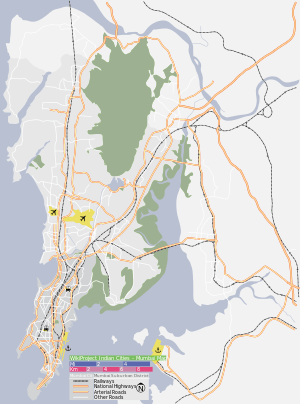Jogeshwari
| Jogeshwari जोगेश्वरी | |
|---|---|
| suburb | |
|
Jogeshwari Caves entrance | |
 Jogeshwari | |
| Coordinates: 19°07′N 72°51′E / 19.12°N 72.85°ECoordinates: 19°07′N 72°51′E / 19.12°N 72.85°E | |
| Country | India |
| State | Maharashtra |
| District | Mumbai Suburban |
| Metro | Mumbai |
| Languages | |
| • Official | Marathi |
| Time zone | IST (UTC+5:30) |
Jogeshwari is a western suburb of Mumbai, situated immediately to the north of Andheri in Maharashtra, India. It is notable for its caves, particularly one containing a shrine of the Hindu god Shiva.
History
In 1915, the Western Trunk Route of Bombay was extended from Bandra to Jogeshwari. Up until 1945, Jogeshwari was administered by a collector in charge of the Bombay Suburban District. With the creation of Greater Bombay in 1945, the administration of Jogeshwari was merged with Bombay city.
Transport
Jogeshwari Railway Station is served by the Western line of the Mumbai suburban railway. A bus depot west of the railway station connects Jogeshwari to various parts of Mumbai. Jogeshwari is connected to the central suburb of Vikhroli via the Jogeshwari-Vikhroli Link Road, usually referred to by its acronym JVLR. The Majas Depot, one of the biggest bus depots in Mumbai, is located along the JVLR in Majasgoan.
Places of interest
Veer Nilesh Sawant Memorial
The Nilesh Sawant Memorial is located in Bandrekarwadi. It was constructed in June 2000 in memory of Nilesh Sawant, who was killed fighting for his country. Nilesh was a resident of Bandrekarwadi. He was a recognized National Level Boxer. Nilesh went to school at Arvind Gandbhir Highschool & Higher Secondary from Chikitsak Samuha's S. S. & L. S. Patkar College of Arts & Science, Goregaon. Nilesh joined the army and was selected for an anti-terrorist operation in Poonch Sector. On 3 June 2000, at Pir Panjal, Nilesh Sawant was killed. Since the army was unable to bring his body down to the base camp, he was cremated at Poonch. Later, his ashes were handed over to his family at Bandrekarwadi, Jogeshwari.
The Jogeshwari Caves
The Jogeshwari caves are located in the eastern part of Jogeshwari. Dedicated to the Hindu god Shiva, the caves are estimated to be 1,500 years old and are some of the oldest cave temples in Mumbai. They are thought to be the work of Buddhist monks and Hindu priests, and they contain ornate sculptures. The size of the cave complex rivals several UNESCO World Heritage sites nearby, such as the cave temples of Ajanta, Elephanta, and Ellora. The Jogeshwari caves are currently in a very poor condition as they are used for such purposes as drying clothes and as toilets by the surrounding slum population.[1]
Kamal Amrohi Studios
Kamal Amrohi Studios (Kamalistan Studios) is located in Jogeshwari east off of the JVLR. The film studio was used as a set for the film Dabangg 2 in 2012.[2]
Education
Jogeshwari has several schools and colleges, including the Ismail Yusuf College. St Mary's high school.
References
- ↑ Patel, Samir. "The Slum and the Sacred Cave" (PDF). Archaeology May/June 2007. Retrieved 26 June 2013.
- ↑ "Salman Khan takes over Kamalistan". The Times of India. 9 March 2012. Retrieved 10 May 2013.
